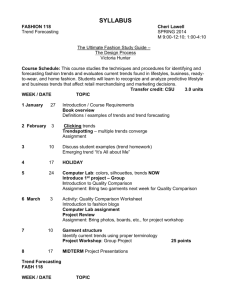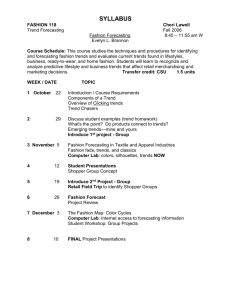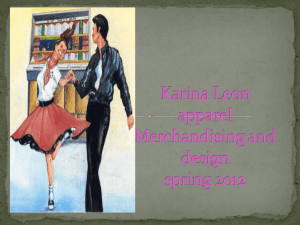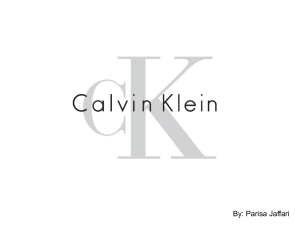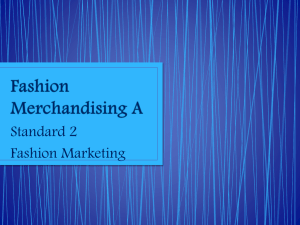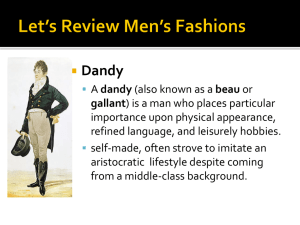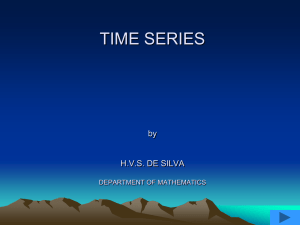Trend Forecasting Process
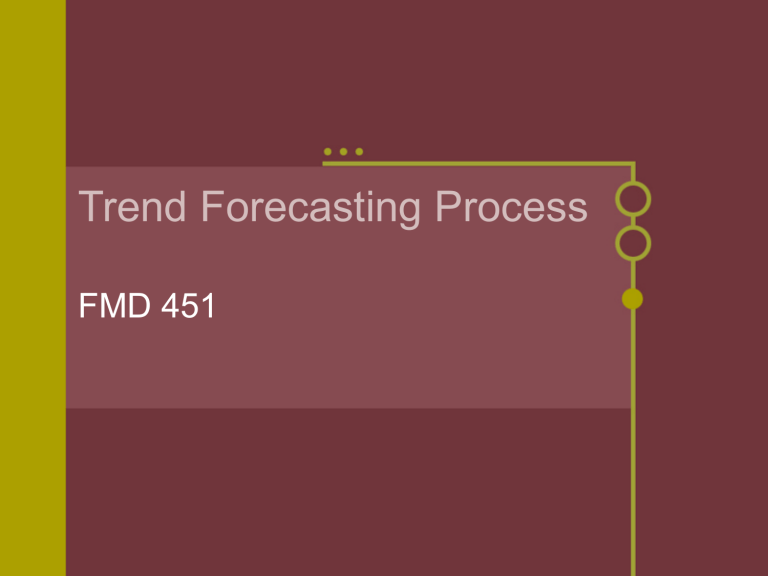
Trend Forecasting Process
FMD 451
Fashion Forecasting
The creative process that can be understood, practiced, and applied by anyone who has the tools.
Need to have a balanced view that seeks out new styles breaking the cultural edge, and the reality of changing demographics, identifies the fad, and the long wave of change.
Uses: product planning, gain market share, position products against competitors, shape collections, style directions, color and textiles directions, ect.
Steps in developing a forecast
1.
2.
3.
4.
5.
6.
7.
ID the facts about past trends/forecasts
Determine cause of change in the past
Look at differences between past forecasts and consumer behavior
Identify factors likely to affect future trends
Apply forecasting tools and techniques accurately.
Follow the forecast continually- see if expectations deviate
Revise the forecast when necessary.
Forecasting Specialties
Long term forecasts- 5 or more years
Short term forecasts- more than one year ahead.
Forecasting Scans-
-
Media Scan
1.
2.
Fashion scansfollow latest fashion and lifestyle trends: visit Fashion capitals, scan media, network with people in the creative fields (arts, entertainment, interior design, cosmetics, and architecture.
Consumer ScansConsumer segmentation (you already did), point of sale data (retailers and manufactures).
Fashion scan + consumer scan= fashion analysis- what will happen next!
Do your research!
1.
2.
3.
Media Scan:
Trend ID, analysis and synthesis
Soak up news that relates to change!
National newspaper-
Wall Street Journal,
New York Times
Trade papers- WWD,
California Apparel
News, Advertising
Age
Fashion and Lifestyle magazines( food, travel, home décor, health, gossip, political, buisness, science, men’s and womens)
4. Internet- Popular
Culture (world wide): coolhunter
5. Watch past fashion shows
6. Take a trip to popular shopping venues, fashionable neighborhoods.
7. Pop Culture: movies, music, TV, books, theater, art.
1.
2.
3.
4.
5.
6.
7.
Media Scan:
Trend ID, analysis and synthesis
Collect bits and pieces from a broad spectrum of sources.
Link signals, shape them into a vision of what the future may be.
Pay attention to:
New and unusual business
Innovative and novel products
Unusual travel destinations
New, rediscovered, or redesigned leisure activities.
New shopping locations,store designs, services.
Stories about people and their adjustment to life’s challenges.
Neighborhoods with interesting mix of people, shopping or ethnic cultures.
Media Scan:
Trend ID, analysis and synthesis
Collect information( folders), organize it into a list of themes, issues, ideas, that capture your attention.
Trends require a label!
Start general and become specific!
-
-general examples: new music, financial issues, cult movies, unusual jobs specific examples: “cyberstyle”,
“GenNesters”, “Asian Influence”
*Once the trend begins to emerge, think about how the trend relates to a specific product category or target market.
Media Scan:
Trend ID, analysis and synthesis
Ideas for Project 2: Media scan
Trend folders
Cite all resources used
You should address all parts of the media scan.
Summarize what your found- Pick 10 major topics/broad categories(20 sources in each) Index them in your paper with sources and images. Summarize in your paper.
Describe the Zeitgeist-
“ The Spirit of the Times”
Fashion is a reflection of the times in which it is created and worn.
Fashion responds to what is modern, all cultural components respond to the spirit of the times.
The Zeitgeist covers all product categories.
Media reports culture but is also shaped by it.
Lifecycles are associated with the Zeitgeist.
“An expression of modernity, of the current state of culture, of the incipient and unarticulated tastes of the consuming public.”
Zeitgeist
Next generation-
Tweens 8-12, looking to computer games and Japanese comic books for inspiration.
Pay attention to: Style interactions between apparel, cuisine, sports, architecture, interiors, automobiles, toys, avocations, pastimes, and play.
1.
2.
3.
4.
5.
6.
7.
Changes in the marketplace:
New fashion- seasonal to continuous
Lack of design leadership
Rules for appropriateness relaxed
Consumers declared independence
Emergence of No fashion-casual Friday, ect.
Cheap chic
Fast fashion
Fashion History Research-
Describe the following:
Designer’s signature style, ex. Tom Ford
1990’s
Style leader- Jacqueline Kennedy1960’s
A fashion lookFlapper look 1920’s
Bohemian element- The hippies, hip hop
Market segment middle class 1950’s
Celebrity Icon- Madonna material girl-
1980’s
ModelTwiggy 1960’s
Fiber/fabric- Chanel Jersey
Timeline
Research
Describe- what is shaping the trend,
Why has the trend developed
Who is leading the trend.
Look to past designs- Cyclical nature of fashion!
Analyze the trends that affect your target market.
Forecast for 2010! Color
Color Story- combined into prints, fabrics, all areas usually 200 pieces per collection.
Work 18-24 months in advance
Color Association of the United States
Psychology of color- color preferences.
Separate for men, women, interiors, youth.
Words used in color
Hue- the color name
Saturation/ chroma- intensity, strength of color,
Value- lightness or darkness of a color.
Tint- white added
Shade- black added
Tone- Grey added
Examples: concentrated, deep, subdue, clear.
Color Marketing- Name
Name a color with imagination, should be able to be used across product categories, understand your customer’s perception of the colors. You want to depict a mood!
Examples from the environment:
Natural phenomena sky, sunshine, grass green.
Flora- poppy red, moss green, orchid
Fauna- flamingo pink, robin egg blue
Gemstones- amber, copper
Food and drink- caramel, champagne,
Spices- paprika, curry red
Dyes- indigo
Building materials- adobe, terra cotta, bronze
Locations- Capri blue
Color Cycles
High chroma-- multi colored--subdue colors-
- earth tones-- achromatic colors (black, white, grey)--purple.
Look at your media scan--- what did you see- colors celebrities were wearing, locations, music covers, interiors, museum exhibits, toys, electronics, food, graphics, ect. What is selling in stores?!
May be done in house or use a professional color system like PANTONE.
Images will help you describe color choices.
Predict 4-7 colors per direction.
Think about season- weather, temperature
Textiles
Overall style: botanical, romantic, folkloric
Interpretation- realistic, abstract, geometric.
Scale- small vs large scale motifs
Figure ground relationship- blank space vs. crowded patterns
Reference to art styles Art Deco
Complexity
Cultural reference- Asian inspired, African motifs
Historic references- time periods
Color story- sherbet colors, tropical, brights with Neutral.
Motifs- golf, seashell, animal print.
The Look: Design
The totality of the look: minimalist, feminine, sexy redifined.
Theme or Mood: gothic romanticisim
Swing of fashion pendulum- flared to narrow
Proportions of piecesplacement of waistline
Silhouette- tubular, hourglass, wedge
Point of emphasisshoulders, bust, waist
Fit- body hugging, loose
Details- collar, pocket, sleeve, cuff
Exaggeration in details.
Trims- beading, feathers, lace
Findings- button, zippers, snaps
Fabric type- woven, knits,
Fabric finishingdyeing, abrasion
Specific fabricstransparent, velvet, ect.
Semiotics
2.
3.
4.
5.
1.
The science of analyzing culture as a system of signs.
Visual concepts:
Referencing the past
Ethnic sources
Sexuality
Sports
Appropriateness-
“uptown chic”
6. Avant-Garde
7. Modernity
8. Postmodern
Trends
Mega Trend- restructuring of culture affects all industries ex. Eco friendly
Major Trend- broad public appeal
Minor Trend- limited or small appeal.
Only refers to a specialized group of consumers.
Describe potential of trend, how long it will last, interaction with other trends.
Trend Reporting; Label the trend
Look- retro, Japanese influence
Mood or spirit- youthful, playful
Lifestyle message
Tie in with celebrity
Target Market- urban youth
Brand image
Concept- career casual
Source of inspiration- Moroccan
Pop culture influence
Forecasting Traps
Time, limitations, assumptions
Lack of imagination, research, insight
Excessive Optimism
Hidden Agendas, wish fulfillment vs. reality
Two sides of the coin- trend and countertrend
Generation gap
Overlapping trends- sectors
Fad vs. Trend
Don’t oversell.
See Appendix for resources
(Mudpie.co.uk, WGSN)
